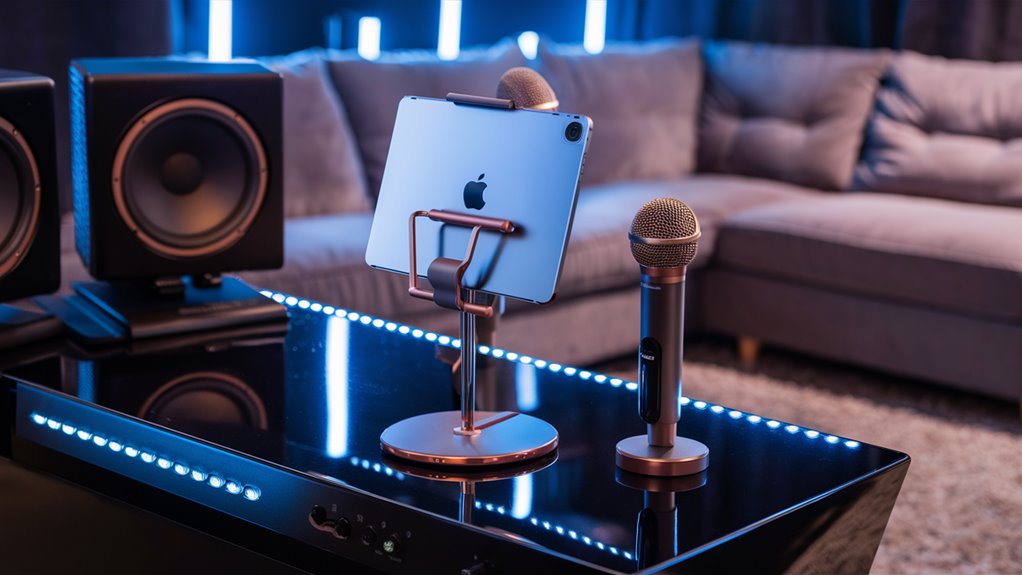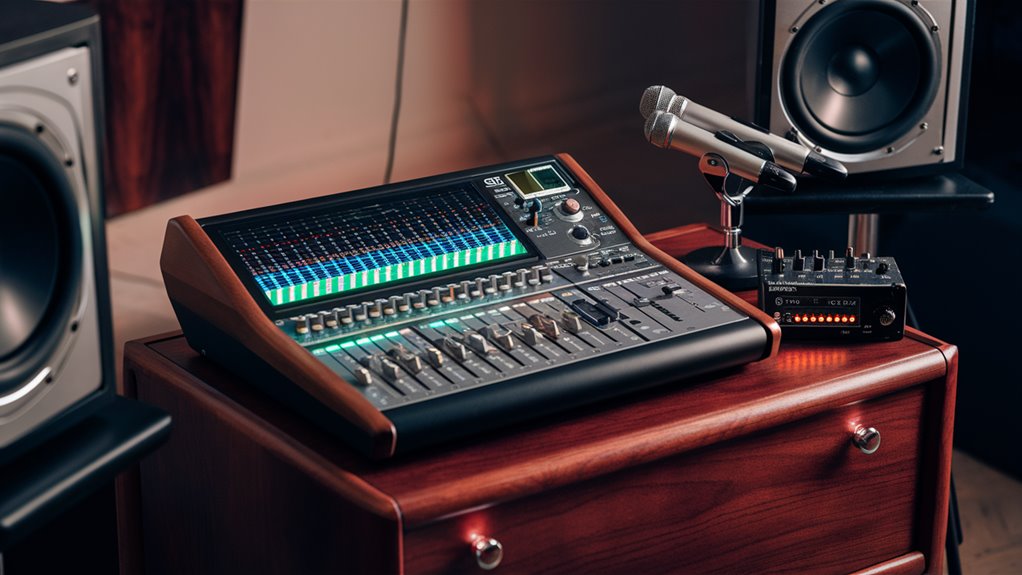The Best Gear for Home Karaoke

To set up the best home karaoke, you need top-notch gear that makes the sound and fun stand out. A strong sound setup is key for good karaoke.
Main Audio Parts
The heart of any great home karaoke system starts with a 200W RMS 2.1 stereo system. Add two wireless mics that clear voice sounds with a 50Hz-15kHz range. A 4-channel mixer with mic preamps and 48V power keeps the sound pro, while built-in DSP fixes pitches for better singing.
Best Speaker Set Up
Put your main speakers 8-10 feet apart at 45-degree angles to match ear level for the best sound spread. A good subwoofer in a corner gives deep, even bass that lifts the karaoke mood without drowning the singing.
Pro Lighting Choices
Wrap up your karaoke space with 12W LED stage lights and RGB LED strips. This lighting makes your room feel like a real karaoke place. Great lights and sounds make a top home karaoke night.
Guide to Key Karaoke System Parts
Needed System Parts
A top karaoke setup needs four key parts working well together to make the best singing night.
Get to know these tech parts to make sure your sound is spot on.
Sound Processing Gear
Start with a high-end karaoke machine or audio unit with:
- 16-bit sound change
- 44.1kHz rate for clear sound mixing
- Many input lines for songs and mics
Pro Mic System
Two wireless mics are must-have for singers, needing:
- Sharp voice pick up
- 50Hz-15kHz voice range
- Clear wireless linking
Needs for Sound Boost
Pro sound boosters should have:
- At least 100 watts RMS output
- Speakers with big sound drivers
- Good room sound reach
Screen Tech Specs
Display parts need:
- Big screens from 40 inches
- Bright projectors
- Fast screens for synced words
- Clear HD screens for easy reading
Wires and Connections
Top-notch links call for:
- Well-balanced mic wires
- Protected sound wires
- HD wires for clear sound/picture
- Protection from signal mess
How to Pick Your Karaoke Mic: The Ultimate Guide
Key Tech Specs
Voice range is key for mic quality, best between 50Hz-15kHz.
Top mics have good sensitivity in dB/mV and cardioid patterns for clear sound without noise.
Wired vs Wireless Quality
Dynamic mics with 250-600 ohms are tough and work well for home karaoke.
Wireless mics let you move free, but need battery care and may have a tiny delay.
Wired setups use XLR or 1/4″ links for steady sound quality.
Extra Features and Specs
Built-in filters and noise cut tech keep your voice clear.
Anti-feedback is a must in small spaces.
Best mics have strong signal-to-noise levels and low distortion for pro sound.
Boosting Performance
Pick mics with built-in sound fixes and echo stops for clearer singing.
Digital sound fixing boosts quality and cuts unwanted noise.
Go for models with adjustable settings and custom sound tweaks for different singing styles and places.
Speakers and Sound for Karaoke
Needed Sound System Parts
A great karaoke night relies on a strong sound system that gives clear, full room sound through well-placed speakers.
A 200-watt RMS sound system is key for fun at home, making sure there’s enough sound for both song playback and singing without losing quality.
Best Speaker Set Up
A 2.1 channel sound setup gives the best sound spread through two main speakers and one subwoofer.
Main speakers should be at ear level, turned 45 degrees to the singing area with 6-8 feet apart. Place the subwoofer on the floor but not in a corner to avoid too much bass.
Tech Specs for Speakers
When picking speakers, go for ones with a wide frequency range and high sensitivity.
Active speakers are easy to set up, but passive systems with separate amps let you tweak more.
Important features include separate sound controls for music and vocals for the best mix quality.
More on Audio Control
- Separate volume knobs for songs and singing
- Full sound range from low to high
- High sensitivity for clearer sound
- Custom sound settings for each use
- Options for both active and passive setups
Guide to the Best Karaoke Apps and Software

Top Karaoke Software Picks
New karaoke software changes how we have fun singing at home, with pro features and big song lists.
Yokee leads with lots of songs and cool sound fixes.
Smule is big for iPhone users with tons of tracks and fun duet options.
What Makes Good Karaoke Software
Three things matter in karaoke software:
- How many songs it has
- How it handles sound
- How quick it works
KaraFun is great with lots of songs and planning well low delay, perfect for live singing.
SingSnap helps make your voice sound better with strong noise tech while keeping the singing quality.
Pro Features and Tech Bits
Virtual DJ Pro stands out in karaoke with:
- Detailed sound controls
- Syncing beats
- High-quality sound work
- Great sound output
For those watching their budget, YouTube Karaoke is free, though it lacks some advanced features like live sound fixes and pro mixing tools.
Paid platforms give more, making sure high-level singers can do their best.
Pro Audio Mixing for Karaoke Systems
Must-Have Mixer Setup
Great karaoke sound depends a lot on good mixing and effects.
A compact 4-channel mixer with mic preamps and separate EQ is key for clear voice sound.
This lets you balance singing and music well while stopping typical sound issues.
Top Voice Processing
Sound squeezing helps make your singing sound like it’s on the radio.
Use a 4:1 squeeze ratio with a -12dB cut to keep the sound even. Quick attack and slow release keep your voice normal.
A bit of reverb adds depth without messing the clarity.
Better EQ and Links
Smart EQ tweaks are a must for the best sound.
Try cutting at 250Hz to clear up the sound, and lift 3kHz to make the voice stand out. Well-matched XLR links keep your setup noise-free.
Pick mixers with cool built-in effects and USB links for easy mixing. 48V power helps use studio mics for top voice sound.
Best Setup for Your Karaoke Singing Space
Good Room Setup and Size
Your karaoke space needs a good 12×15 foot area for best sound and fun.
Smart gear placing makes the singing feel real.
Sound Gear Spots
Put your main speakers 8-10 feet apart at a 45-degree angle, with tweeters at about 4 feet up for top sound reach.
The subwoofer works best in a corner, boosting low sound and room feel.
Screen Setup
Hang your screen or TV about 5-6 feet up, keeping it 6 feet from where you sing.
A 55-inch screen is best for this setup, but match it to your room size.
Keep your mic stand 4 feet from the screen, leaving 8-10 feet between you and the watchers.
Cables and Lights Done Right
Use good cable setups with wall paths, keeping a safe 3-foot gap between sound and power wires to stop noise.
Put LED lights high at 7 feet on the back wall, angled at 30 degrees to add depth and stop screen shine.
Top Guide to Pro Karaoke Lighting
Main Lighting Parts for Karaoke
Turning a normal room to a fun karaoke spot needs smart light choices.
A 12W LED PAR stage light placed right at 45 degrees and 8 feet from where you sing lights your face well and cuts harsh shadows.
Fun Light Moves and Controls
Pro karaoke feels need smart light control.
A 4-channel DMX controller with twin 6-inch spinning disco balls covers all the room for up to 400 square feet.
Smart strobe spots at 30% light in corners balance the light all over.
UV LED black lights (24W) up high boost bright parts and add depth.
More Mood Lighting Choices
RGB LED strip lights (5050 RGB, 300 LEDs per 16.4ft) set low creates needed depth. Keeping these lights at 70% makes sure they work well with your main lights.
A 400W fog machine set for short bursts keeps the mood pro while keeping the words clear.
Best Light Specs for the Best Show:
- Main Stage Light: 12W LED PAR
- Spinning Effects: Twin 6-inch disco balls
- Edge Lights: 5050 RGB LED strips
- Mood Control: 400W fog setup
- Bright Boost: 24W LED black lights
